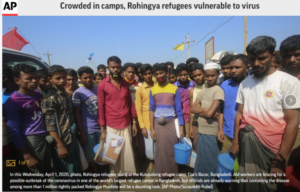I promised over the last few months to update readers about what was happening in refugee camps with COVID, and as of this morning I can report NOT MUCH!

(In addition to the post linked above, see some of my previous posts here, here, and here for example.)
I’m not planning to spend hours trying to find articles hidden in the dark recesses of the world wide web that might prove that the virus has developed into a “grave threat” for hundreds of thousands of refugees (living in close quarters without masks!) as the mainstream media was predicting for months.
There are many articles including this one below that discuss how the UN and other agencies have kept refugees safe, but they make me chuckle.
Since they can’t report some horrifying death toll, they are now taking credit for keeping the virus at bay in camps where dozens of people share latrines for their daily excretions, soap and water are not plentiful and they live in crowded huts (so much for social distancing).
You know if the case numbers and death toll was high we would be hearing about it from the front pages of the WaPo and the NYT!
From Relief Web:
Bangladesh, 24 August 2020: The global death toll from the coronavirus has crossed 800,000 as confirmed cases surged past 23 million, with Bangladesh overtaking Pakistan to become 15th on the list of countries with most COVID-19 patients. While the country has crossed a grim milestone, there are so far fewer causalities in the densely-populated Rohingya camps that have been and still are considered one of the most vulnerable places to the ongoing pandemic.
As of now, COVID-19 situation across the camps has been tackled somewhat successfully. However, the apparent success in keeping the virus away should not hide the fact that the risks of a COVID-19 outbreak in the camps remain very high. Despite taking all the preventative measures, it cannot fully alleviate the very difficult conditions continually present in the camps.
[….]
“Close to a million Rohingya refugees are living in highly overcrowded camps in the Cox’s Bazar region of Bangladesh. So far with the collective effort of all humanitarian agencies and the government we have been able to limit the spread of COVID-19 successfully. However, the risk still remains and we need to keep working with the communities on food and nutrition security, creating health awareness while reinforcing our disaster preparedness activity”- said Ram Das, Deputy Country Director – Humanitarian Response of CARE Bangladesh.
Sure seems like the international health establishment should be figuring out why the virus isn’t spreading where it seems that it should be—in crowded and unhealthy living conditions housing the “vulnerable.”
And, that reminds me, why isn’t there a huge sick/death count in the tent cities where the homeless are congregating in Democrat controlled cities?
